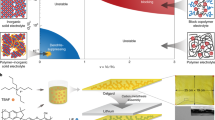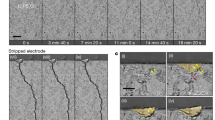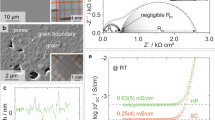Abstract
A critical current density on stripping is identified that results in dendrite formation on plating and cell failure. When the stripping current density removes Li from the interface faster than it can be replenished, voids form in the Li at the interface and accumulate on cycling, increasing the local current density at the interface and ultimately leading to dendrite formation on plating, short circuit and cell death. This occurs even when the overall current density is considerably below the threshold for dendrite formation on plating. For the Li/Li6PS5Cl/Li cell, this is 0.2 and 1.0 mA cm−2 at 3 and 7 MPa pressure, respectively, compared with a critical current for plating of 2.0 mA cm−2 at both 3 and 7 MPa. The pressure dependence on stripping indicates that creep rather than Li diffusion is the dominant mechanism transporting Li to the interface. The critical stripping current is a major factor limiting the power density of Li anode solid-state cells. Considerable pressure may be required to achieve even modest power densities in solid-state cells.
This is a preview of subscription content, access via your institution
Access options
Access Nature and 54 other Nature Portfolio journals
Get Nature+, our best-value online-access subscription
$29.99 / 30 days
cancel any time
Subscribe to this journal
Receive 12 print issues and online access
$259.00 per year
only $21.58 per issue
Buy this article
- Purchase on Springer Link
- Instant access to full article PDF
Prices may be subject to local taxes which are calculated during checkout






Similar content being viewed by others
Data availability
Supporting research data has been deposited in the Oxford Research Archive and is available at https://doi.org/10.5287/bodleian:gA47ppAz9.
References
Hooper, A. & Tofield, B. C. All-solid-state batteries. J. Power Sources 11, 33–41 (1984).
Kerman, K., Luntz, A., Viswanathan, V., Chiang, Y.-M. & Chen, Z. Review—practical challenges hindering the development of solid state Li ion batteries. J. Electrochem. Soc. 164, A1731–A1744 (2017).
Janek, J. & Zeier, W. G. A solid future for battery development. Nat. Energy 1, 16141 (2016).
Zhou, W. et al. Polymer lithium-garnet interphase for an all-solid-state rechargeable battery. Nano Energy 53, 926–931 (2018).
Pang, Q., Liang, X., Shyamsunder, A. & Nazar, L. F. An in vivo formed solid electrolyte surface layer enables stable plating of Li metal. Joule 1, 871–886 (2017).
Cheng, E. J., Sharafi, A. & Sakamoto, J. Intergranular Li metal propagation through polycrystalline Li6.25Al0.25La3Zr2O12 ceramic electrolyte. Electrochim. Acta 223, 85–91 (2017).
Nagao, M. et al. In situ SEM study of a lithium deposition and dissolution mechanism in a bulk-type solid-state cell with a Li2S-P2S5 solid electrolyte. Phys. Chem. Chem. Phys. 15, 18600–18606 (2013).
Monroe, C. & Newman, J. The impact of elastic deformation on deposition kinetics at lithium/polymer interfaces. J. Electrochem. Soc. 152, A396 (2005).
Monroe, C. & Newman, J. Dendrite growth in lithium/polymer systems. J. Electrochem. Soc. 150, A1377 (2003).
Lotsch, B. V. & Maier, J. Relevance of solid electrolytes for lithium-based batteries: a realistic view. J. Electroceram. 38, 128–141 (2017).
Porz, L. et al. Mechanism of lithium metal penetration through inorganic solid electrolytes. Adv. Energy Mater. 7, 1–12 (2017).
Swamy, T. et al. Lithium metal penetration induced by electrodeposition through solid electrolytes: example in single-crystal Li6La3ZrTaO12 garnet. J. Electrochem. Soc. 165, A3648–A3655 (2018).
Sharafi, A., Haslam, C. G., Kerns, R. D., Wolfenstine, J. & Sakamoto, J. Controlling and correlating the effect of grain size with the mechanical and electrochemical properties of Li7La3Zr2O12 solid-state electrolyte. J. Mater. Chem. A 5, 21491–21504 (2017).
Sharafi, A. et al. Surface chemistry mechanism of ultra-low interfacial resistance in the solid-state electrolyte Li7La3Zr2O12. Chem. Mater. 29, 7961–7968 (2017).
Han, X. et al. Negating interfacial impedance in garnet-based solid-state Li metal batteries. Nat. Mater. 16, 572–579 (2017).
Botros, M., Djenadic, R., Clemens, O., Möller, M. & Hahn, H. Field assisted sintering of fine-grained Li7-3xLa3Zr2AlxO12 solid electrolyte and the influence of the microstructure on the electrochemical performance. J. Power Sources 309, 108–115 (2016).
Yonemoto, F. et al. Temperature effects on cycling stability of Li plating/stripping on Ta-doped Li7La3Zr2O12. J. Power Sources 343, 207–215 (2017).
Manalastas, W. et al. Mechanical failure of garnet electrolytes during Li electrodeposition observed by in-operando microscopy. J. Power Sources 412, 287–293 (2019).
Basappa, R. H., Ito, T. & Yamada, H. Contact between garnet-type solid electrolyte and lithium metal anode: influence on charge transfer resistance and short circuit prevention. J. Electrochem. Soc. 164, A666–A671 (2017).
Koerver, R. et al. Chemo-mechanical expansion of lithium electrode materials—on the route to mechanically optimized all-solid-state batteries. Energy Environ. Sci. 11, 2142–2158 (2018).
Koerver, R. et al. Capacity fade in solid-state batteries: interphase formation and chemomechanical processes in nickel-rich layered oxide cathodes and lithium thiophosphate solid electrolytes. Chem. Mater. 29, 5574–5582 (2017).
Koshikawa, H. et al. Dynamic changes in charge-transfer resistance at Li metal/Li7La3Zr2O12 interfaces during electrochemical Li dissolution/deposition cycles. J. Power Sources 376, 147–151 (2018).
Jow, T. R. & Liang, C. C. Interface between solid electrode and solid electrolyte—a study of the Li/LiI(AI2O3) solid-electrolyte system. J. Electrochem. Soc. 130, 737–740 (1983).
Jow, T. R. & Liang, C. C. Interface between solid anode and solid electrolyte-effect of pressure on Li/LiI(Al2O3) interface.Solid State Ion. 9-10, 695–698 (1983).
Han, F. High electronic conductivity as the origin of lithium dendrite formation within solid electrolytes. Nat. Energy 4, 187–196 (2019).
Krauskopf, T., Hartmann, H., Zeier, W. G. & Janek, J. Toward a fundamental understanding of the lithium metal anode in solid-state batteries—an electrochemo-mechanical study on the garnet-type solid electrolyte Li6.25Al0.25La3Zr2O12.Appl. Interfaces Mater. 11, 14463–14477 (2019).
Zhang, Z. et al. New horizons for inorganic solid state ion conductors. Energy Environ. Sci. 11, 1945–1976 (2018).
Zheng, F., Kotobuki, M., Song, S., Lai, M. O. & Lu, L. Review on solid electrolytes for all-solid-state lithium-ion batteries. J. Power Sources 389, 198–213 (2018).
Kato, Y. et al. High-power all-solid-state batteries using sulfide superionic conductors. Nat. Energy 1, 16030 (2016).
Zhou, L. et al. Solvent-engineered design of argyrodite Li6PS5X (X = Cl, Br, I) solid electrolytes with high ionic conductivity. ACS Energy Lett. 4, 265–270 (2019).
Deng, Z., Wang, Z., Chu, I.-H., Luo, J. & Ong, S. P. Elastic properties of alkali superionic conductor electrolytes from first principles calculations. J. Electrochem. Soc. 163, A67–A74 (2016).
Yu, C., van Eijck, L., Ganapathy, S. & Wagemaker, M. Synthesis, structure and electrochemical performance of the argyrodite Li6PS5Cl solid electrolyte for Li-ion solid state batteries. Electrochim. Acta 215, 93–99 (2016).
Wenzel, S., Sedlmaier, S. J., Dietrich, C., Zeier, W. G. & Janek, J. Interfacial reactivity and interphase growth of argyrodite solid electrolytes at lithium metal electrodes. Solid State Ion. 318, 102–112 (2018).
Wu, E. A. et al. New insights into the interphase between the Na metal anode and sulfide solid-state electrolytes: a joint experimental and computational study. ACS Appl. Mater. Interfaces 10, 10076–10086 (2018).
Zhu, Y., He, X. & Mo, Y. Origin of outstanding stability in the lithium solid electrolyte materials: insights from thermodynamic analyses based on first-principles calculations. ACS Appl. Mater. Interfaces 7, 23685–23693 (2015).
Wang, M., Wolfenstine, J. B. & Sakamoto, J. Temperature dependent flux balance of the Li/Li7La3Zr2O12 Interface. Electrochim. Acta 296, 842–847 (2019).
Nemat‐Nasser, S. & Hori, M. Void collapse and void growth in crystalline solids. J. Appl. Phys. 62, 2746–2757 (1987).
Masias, A., Felten, N., Garcia-Mendez, R., Wolfenstine, J. & Sakamoto, J. Elastic, plastic, and creep mechanical properties of lithium metal. J. Mater. Sci. 54, 2585–2600 (2019).
Acknowledgements
P.G.B. is indebted to the Faraday Institution All-Solid-State Batteries with Li and Na Anodes (FIRG007, FIRG008), as well as the Engineering and Physical Sciences Research Council (EPSRC), including the SUPERGEN Energy Storage Hub (EP/L019469/1), Enabling Next Generation Lithium Batteries (EP/M009521/1), the University of Oxford experimental equipment upgrade (EP/M02833X/1) and the Henry Royce Institute for capital equipment (EP/R010145/1) for financial support. The authors thank Dr Phil Holdway, Oxford Materials Characterisation Service, for help with XPS measurements.
Author information
Authors and Affiliations
Contributions
J.K. contributed to all aspects of the research. S.Z. performed the SEM experiments and analysed the data. D.S.J. performed electrochemical experiments and analysed the data. Z.N. performed synthesis of Li6PS5Cl and in situ tomography experiments. P.G.B., J.K., S.Z., D.S.J., Z.N., G.O.H. and J.M. interpreted the data. P.G.B. wrote the paper with contributions from J.K., S.Z., D.S.J., Z.N. and G.O.H. The project was supervised by P.G.B.
Corresponding author
Ethics declarations
Competing interests
The authors declare no competing interests.
Additional information
Publisher’s note: Springer Nature remains neutral with regard to jurisdictional claims in published maps and institutional affiliations.
Supplementary information
Supplementary Information
Supplementary Figs. 1–7.
Rights and permissions
About this article
Cite this article
Kasemchainan, J., Zekoll, S., Spencer Jolly, D. et al. Critical stripping current leads to dendrite formation on plating in lithium anode solid electrolyte cells. Nat. Mater. 18, 1105–1111 (2019). https://doi.org/10.1038/s41563-019-0438-9
Received:
Accepted:
Published:
Issue Date:
DOI: https://doi.org/10.1038/s41563-019-0438-9
This article is cited by
-
Sulfide-based composite solid electrolyte films for all-solid-state batteries
Communications Materials (2024)
-
External-pressure–electrochemistry coupling in solid-state lithium metal batteries
Nature Reviews Materials (2024)
-
Deciphering the critical role of interstitial volume in glassy sulfide superionic conductors
Nature Communications (2024)
-
Li–Solid Electrolyte Interfaces/Interphases in All-Solid-State Li Batteries
Electrochemical Energy Reviews (2024)
-
Monothetic and conductive network and mechanical stress releasing layer on micron-silicon anode enabling high-energy solid-state battery
Rare Metals (2024)



